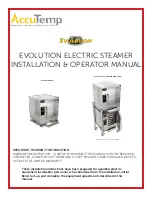
5
ImporTanT safeTy InformaTIon
Cooking under pressure enables you to prepare food both quickly and deliciously. If used properly, your pressure cooker is one of the
safest appliances in your kitchen. To ensure safe operation, make sure you always observe the following simple rules whenever you use
the pressure cooker:
1.
Never overfill the pressure cooker.
— The pressure regulator is designed to maintain cooking pressure at a safe level. It relieves
excess pressure through the vent pipe as it rocks back and forth.
Many foods tend to expand when cooked. If the cooker is overfilled,
expansion of food may cause the vent pipe to become blocked or clogged. In the event that the vent pipe becomes blocked, there are
two backup safety devices which are intended to release excess pressure: the pressure relief valve and the overpressure plug. It is
possible, however, to block them as well if the cooker is overfilled.
Do not fill the cooker more than ⅔ full when cooking most foods. when cooking foods that
foam, froth, or expand, such as rice, grains, dry beans and peas, or foods that are mostly
liquid, such as soups, never fill the cooker more than
½
full.
For your convenience, both the ⅔
and ½
full levels are marked by indentations on the side
of the pressure cooker body (Fig. M). The upper marking indicates the ⅔ full level and the
lower the
½
full level. In addition, in each section of the recipes you will find instructions
on the maximum fill level for each type of food.
Reminder: When cooking any food, do not let any portion extend above the maximum
fill mark. When cooking rice, grains, dry beans and peas, soups, and stews, the cooker should never be more than ½ full.
2.
Never pressure cook applesauce, cranberries, rhubarb, cereals, pastas, dried soup mixes, or dry beans and peas which are
not listed in the chart on page 24.
— These foods expand so much as a result of foaming and frothing that they should never be
cooked under pressure.
3.
Always add cooking liquid.
— If an empty pressure cooker is left on a hot burner or if a cooker boils dry and is left on a heated
burner, the cooker will overheat excessively causing possible discoloration and/or damage to the cooker.
4.
Always look through the vent pipe before using the cooker to make sure it is clear.
— If the vent pipe is blocked, it cannot
function as it should and thus cannot relieve excess pressure. Pressure may then build to unsafe levels. To clean the vent pipe, see
page 6.
5.
Always fully close the pressure cooker.
— The cooker is fully closed when the cover handle is directly above the body handle. Your
pressure cooker has specially designed lugs on the cover and body which lock the cover in place when the cooker is fully closed.
However, if the cooker is not fully closed, the lugs cannot lock the cover onto the body. It’s possible that pressure could build inside
the cooker and cause the cover to come off and result in bodily injury or property damage. Always be sure the cover handle is directly
above the body handle (see page 4, Fig. H). Do not turn past handle alignment.
6.
Never open the cooker when it contains pressure.
— The air vent /cover lock provides a visual indication of pressure inside the
cooker. when it is up, there is pressure. when it is down, there is no pressure in the cooker and it can be opened.
If the pressure cooker is opened before all of the pressure is released, the contents of the cooker will erupt and could cause bodily
injury or property damage.
7.
Respond to a warning from the pressure relief valve.
— The pressure relief valve is a warning device that is designed to provide
both visual (the blue cap lifts and steam comes out the sides) and audio (a fast, steady release of steam, often times accompanied
by a continuous unpleasant sound) signals to indicate that the vent pipe has been blocked and is no longer regulating pressure and
there is excessive pressure in the cooker. If you see and/or hear either of these signals, immediately turn off the burner. Do not move
the cooker. Instead, allow pressure to drop of its own accord. when there is no pressure in the cooker (see #6, above), remove the
pressure regulator from the cover, open the cooker, and clean the vent pipe (see #3, page 6).
NOTE:
Do not operate the cooker again until you have replaced the pressure release valve.
The high pressure which triggered the release may have contaminated the valve with food particles, which could prevent it from
acting as a warning and a backup pressure release valve if the vent pipe is plugged again.
Remember a plugged vent pipe is a result of user error.
•
Never
overfill the cooker.
•
Never
cook the foods listed in #2, above in a pressure cooker.
•
Always
follow the special procedures when cooking rice, grains, and dry beans and peas (see #11, page 6)
.
8.
Never tamper with the internal components of the pressure relief valve.
— The pressure relief valve is a very sensitive part and
can be easily damaged. when replacing the pressure relief valve, the entire part must be replaced.
9.
Replace the sealing ring if it becomes hard, deformed, cracked, worn, pitted, or soft and sticky.
— The sealing ring provides
a pressure tight seal between the cover and stainless steel body. The sealing ring needs to be in good condition to function properly.
Failure to replace the sealing ring when it is hard, deformed, cracked, worn, pitted, or soft and sticky could result in bodily injury or
property damage.
⅔ fill line
½ fill line
Fig. M






































